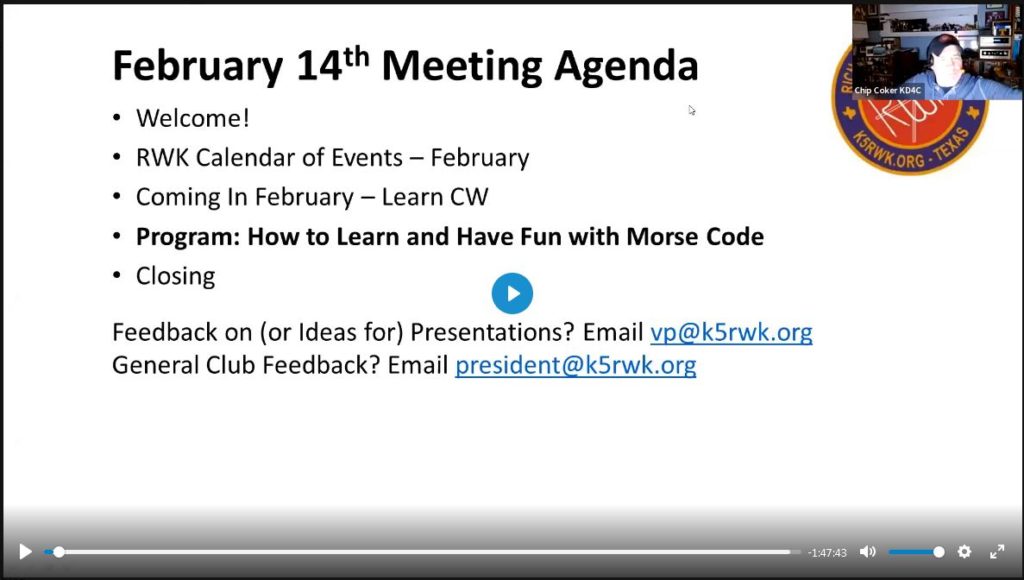Do you want to learn CW? We’re partnering with the Long Island CW Club to bring a structured approach to learning the oldest Ham Radio communication method.
How Does It Work?
The Long Island CW Club conducts online classes that introduce and teach CW characters using proper and proven methods. These sessions are offered multiple times per week and the learner is expected to attend one session per week (usually at the same time every week). In addition to the online sessions, there is some self-study between sessions.
RWK is also offering group practice between RWK members, either online or on the air (since most of us are close to each other), that will be held in conjunction with the LICW sessions. There will also be there will be periodic QSO nights where you can practice contacts with other RWK members in a low-stress manner.
What Do I Need?
You’ll need:
- A Computer (connected to the internet) with the Zoom! client installed, and a camera and speakers/headphone and microphone
- CW Practice Software (installed on a PC) – G4FON CW Practice Software or F6DQM CW Player
- A Straight Key and/or Keyer Paddles (and electronic keyer with internal sidetone if your radio doesn’t have audible sidetone)
How Do I Get Started?
You will need to register with the LICW ($30 donation for an annual membership) to gain access to their online CW sessions. After you are registered, we suggest that you:
- Attend one of the LICW Intro Class (Introductory training on general LICW things (files and resources and how to use the CW practice software, Zoom, what keys and oscillators to get and general practice on the first 10 characters in preparation for entry into the Beginners 1 class). The Intro Classes are usually on Monday Nights @ 6pm Central. There is also a specific class on software setup if needed.
- Pick one of the LICW Beginners 1 (B1) & B2 weekly session tracks to attend. These session tracks last around 3 months and periodically “reset” (start over with simple characters) and start the progression of learning (usually) 3-4 characters per week. You can start with any session but we recommend that you start with a session that has recently “reset”. We recommend that you attend the same session every week so that you can keep up with the progression. David K5CU will know which sessions will be the best to start with. You can see the full calendar here.
- Do the suggested weekly self-study with the code practice software, as suggested by your LICW session leader.
- Participate in a weekly RWK group session to practice your skills with other RWK members.
- Participate in QSO Nights on the air with other RWK members in a low-pressure setting.
How Much Time Will It Take?
You should be prepared to dedicate at least 2 hours a week – One for the structured LICW B1 & B2 sessions and at least one to practice sending and receiving on your own and with your fellow klub members in group sessions. Of course, the more time that you spend, the quicker that you will learn.
Who Do I Ask If I Have Questions?
David Nathanson K5CU is the RWK Leader for this program. He knows the details of the LICW sessions and he will be scheduling the RWK practice sessions and QSO Nights.
Who Is The Long Island CW Club?

The Long Island CW Club was established in January 2018, and has quickly grown to over 2100 members branching out into 50 states and 33 countries. They hold beginner, intermediate and advanced CW classes 68 times per week via internet video conference, (Zoom), practicing copy and sending. Classes move at the pace of the student in a relaxed environment without fixed goals, with the objective to get the student on the air as soon as possible. Getting on the air quickly leads to higher motivation to keep learning and practicing. You can read more about the Long Island CW Club at https://longislandcwclub.org/
What Other Resources Are Available?
The CW Practice Software is good for random character generation and learning the elements of the code. LICW has files of random characters for download and use with the CW software.
When you get more proficient, you will want to transition towards listening to actual CW QSOs instead of random characters.
Don’t forget about the ARRL Code Practice sessions which are also a great resource. The ARRL transmits code practice sessions on most bands every night, so you can listen on the air and get a feel for receiving code coupled with actual band conditions. The ARRL code practice transmits text from a recent issue of QST, so you can practice copying (and listening to) words in your head and then check what you heard with QST later. There are slow and fast sessions and they alternate nights.
On-The-Air Practice
Weekly CW Slow Speed Test – From the K1USN Radio Club, twice weekly (Friday afternoon and Sunday evening) hour long opportunities to work CW on the air at a slower speed (up to 20 WPM).
February 2022 RWK General Meeting
For more information and to get inspired to Learn CW, watch the presentation from Howard Bernstein WB2UZE and Jim Crites W6JIM from the Long Island CW Club as part of the RWK February 2022 Meeting.


What Hardware Do I Need?
You will need a basic “straight key” to send CW (or you can skip the straight key and go directly to learning to send with Paddles and a keyer). Most modern HF radios include a built-in electronic keyer function, so all you need is a set of paddles.
Straight Key
The “straight key” was the traditional method used to send CW. Many people learn on a straight key and then progress on to an electronic keyer with paddles (see below). Straight keys vary in design but operation is all very similar. You can always find straight keys at hamfests, swapmeets and online sites like eBay.


Electronic Keyer with Side Tone
Electronic keyers improve your sending of CW by forming perfect dits and dahs and enforcing the spacing between elements. They are activated with a set of paddles (on for the dit and the other for the dah), sometimes referred to as “squeeze paddles” because to send you just squeeze the paddles together in a particular order. Many current HF radios contain a built-in electronic keyer function, and cheap external electronic keyers are available at hamfests and eBay.

Keyer Paddles
Paddles for electronic keyers are sometimes works of art. A classic and well-regarded design is the BY-1 from Bencher (they have been sold for over 40 years and vintage Bencher paddles really hold their value).

My preferred paddles were sold by Ham Radio Center in the 1980s and 1990s and were a copy of a Brown Brothers design. You can still find these used on eBay.

Stay away from anything that is 3D printed or that does not have a HEAVY base – you need the paddles to stay stationary on the table while you are sending. That’s why all the good paddles are mounted to a big hunk of metal. You will quickly tire of trying to send with one hand and hold the paddles steady with the other.
(KD4C)
